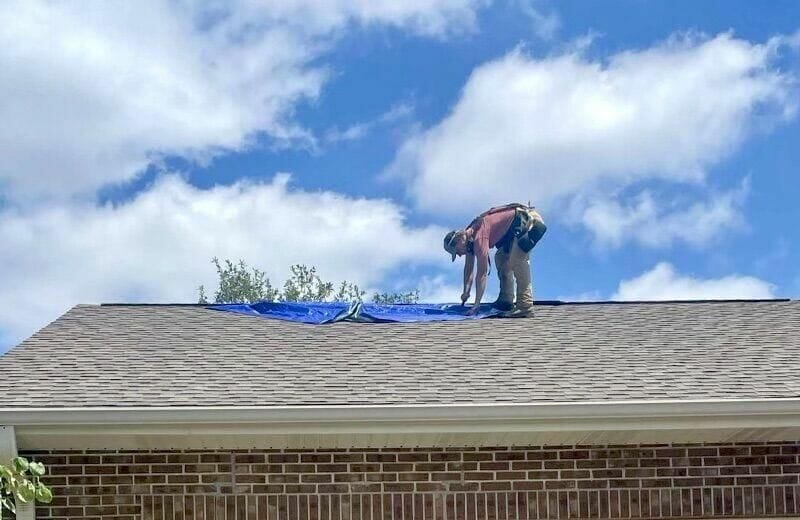Outdoor Workers Make Adjustments to Survive Extreme Heat Working Early, Breaking Often
Published August 25th, 2023 at 2:22 PM
Above image credit: David Richardson, a Kansas City Public Works employee, said the safety of workers in extreme heat requires a team effort. (Teagan King | Missouri Business Alert)June and July both brought heat waves and record-high average global temperatures. This week, heat index values have tied decades-old records in parts of the Midwest, subjecting many outdoor workers to extreme conditions.
Extreme heat leads to an additional 120,000 occupational injuries annually, according to a 2021 study from the Adrienne Arsht-Rockefeller Foundation’s Resilience Center. The study found that, in 2020, heat caused $100 billion of losses in U.S. worker productivity.
Sirisha Naidu, an associate professor of economics at the University of Missouri-Kansas City who researches environmental economics, said it is important to examine what the losses mean for working people.
“Sometimes people think of the economy just in terms of businesses, but we can also think of the economy as people,” Naidu said. “What is the impact on their employment? … And then what is the impact on their health, because that has implications on whether they can or cannot work.”
Missourians in different jobs whose work requires them to be outdoors are contending with record heat in different ways.
Working Early, Breaking Often
Jason Mendenhall, president of Laborer’s Local Union 663, which represents about 2,000 members across 35 counties, said the heat is a real concern for construction workers across Missouri.
“We’re talking about some areas of the state where the heat index is rising to somewhere between 120 and 130 degrees. That’s dangerous,” said Mendenhall. “There are some very, very simple precautions that a lot of our contractors are taking.”
“What is the impact on their employment? And then what is the impact on their health, because that has implications on whether they can or cannot work.” – Sirisha Naidu, environmental economist
Precautions include asking employees to take 10-minute breaks every hour so they can sit in the shade or an air-conditioned truck and stay hydrated. Another tactic utilized by some contractors is beginning their workdays earlier.
Mendenhall said a typical workday is from 7 a.m. to 3:30 p.m. But for this week, some contractors are reducing their hours to 5 or 6 a.m. to noon.
“I only know of two or three contractors that work full days,” Mendenhall said of contractors in the Kansas City area. “But even though they worked full days, they were requiring everybody to take a 10-minute break.”
Mendenhall encourages his union members to take personal responsibility, and after working in the sun, to stay hydrated, avoid alcohol and get plenty of rest.
“Rest is just so unbelievably key to how the body functions, and more importantly how well it’s going to function under stress,” he said. “And when you’re talking about extreme temperatures, your body’s under extreme stress, and the well-rested body handles that stress better.”
‘A Minute to Breathe’
Jackson Henley, a landscape technician in Kansas City, started his job in March and is in his first summer landscaping outdoors. While he is new to the job, he has seen the heat’s effects on some of his older coworkers and uses this as a reminder to take care of his health.
“It’s a lot of older guys that have stuck with it for years and years and years, so you’ve seen what it’s done to them, you see their skin. … They might be 30, but it’s looking like they got 50-, 60-year-old skin,” he said. “It really helps to take into perspective what you need to look out for.”
If the weather reaches the point where his supervisors become worried about the workers’ health, Henley said they will be sent home early or work a half day.
Henley said guidelines should be created that can apply to all companies to standardize their extreme heat responses.
“It’s needed,” he said. “These people aren’t out here slacking and trying to get minutes on their phone; they’re trying to get a minute to breathe and cool off.”
A Team Effort
In 38 years working outside in a range of jobs, Kansas City Public Works employee David Richardson has seen a lot of change.
Richardson said this is one of the hottest summers he’s ever experienced while on the job, though he and other outdoor workers are now provided with improved tools to handle the heat, like better air-conditioned trucks.
“It’s a major upgrade, what we have now, because when I started, they wouldn’t give you all that. … It was just, ‘Get out there and work,’” he said.
“These people aren’t out here slacking and trying to get minutes on their phone; they’re trying to get a minute to breathe and cool off.” – Jackson Henley, landscape technician
As a Public Works supervisor, Richardson checks on other workers to make sure they are safe and healthy in the heat and provides water for them.
It is essential to their well-being to treat safety in the heat as a team effort, Richardson said. Each employee needs to be looking out for their own safety, but also checking on others around them and understanding that everyone may have a different tolerance for heat.
Kansas City Public Works Department employees largely handle trash collection and infrastructure projects like street resurfacing, so the department holds seasonal meetings to prepare for issues related to outdoor work, said Michael Shaw, the department’s director.
Workers are advised to walk in the shade as much as possible and take breaks in air-conditioned trucks. Supervisors also conduct multiple observations daily to monitor workers’ well-being and drop off cold water bottles, Shaw said.
Acclimating to Outdoor Work
Rylan Martin, a part-time construction worker and owner of a lawn care company in Cape Girardeau, believes the weather hasn’t been too bad this year.
“Other than putting some clouds in front of the sun, I don’t think there’s much (bosses) can do really,” Martin said of the heat. “It is just what it is, but … you kind of get used to it.”
Martin said he works from 6 or 7 a.m. until 2 or 3 p.m. on construction jobs in extreme heat.
He has not mowed lawns for the last week due to the heat.

Martin has been working outdoors since 2020, and in just a few years he said he’s already gotten used to the heat. Martin stays hydrated by bringing a 64-ounce water jug and two or three bottles of water or sports drinks.
“I love being outside,” he said, “and I wouldn’t want to do anything else really.”
High Heat in Warehouses
Paul Presely, a truck driver and Springfield native, has been working in the business for 36 years. He spent 14 of those years inside the warehouse of a packaging and shipping company and has lots of experience with extreme heat.
In high temperatures, workers in the warehouse take a lot more breaks and get more water, Presely said. There are signs all over the facility explaining signs of heatstroke and how to stay hydrated.
“They’re always trying to reinforce hydration and make sure that people are aware, and not overheating,” Presely said. “That’s all part of our safety department. They take care of all that.”
Presely said his company does a great job of making sure workers are taking necessary precautions, but has seen worse conditions with other companies and occupations.
Teagan King is a University of Missouri journalism student and summer reporting intern at Kansas City PBS and Missouri Business Alert, a fellow member of the KC Media Collective. Jessie Scowcroft and Ansley Franco are reporters at Missouri Business Alert.





